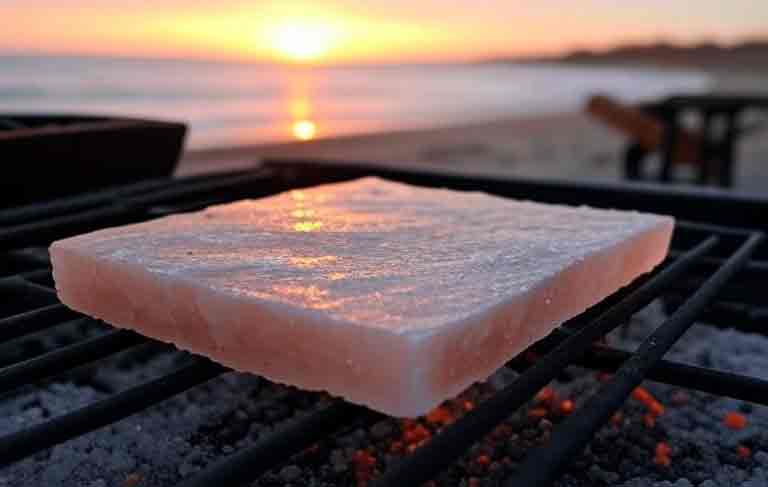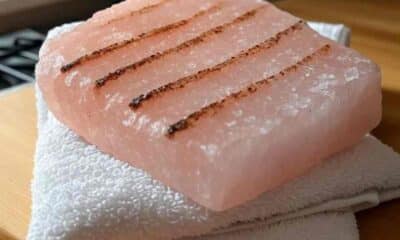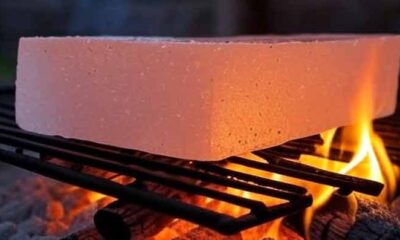Himalayan Salt Block
Himalayan Salt Block Impact: Environmental Considerations
Himalayan Salt Block Impact: Environmental Considerations
As a coastal cook shaped by the briny air of Newport, Rhode Island, I often reflect on how Himalayan salt block impact touches the natural world, guiding my BBQ choices with care. In my Cannon Beach kitchen, where the ocean’s rhythm inspires my cooking, this pink slab’s glow recalls sunsets over the waves. Yet, its journey from Pakistan’s mines to my grill carries an environmental story of give-and-take. I’m excited to share this guide to mindful use, helping you make choices that honor the earth. Let’s explore the Himalayan salt block impact and how we can grill sustainably.

Himalayan salt block on the beach at sunset.
The Mining Process and Its Environmental Footprint
The Himalayan salt block impact begins at the Khewra Salt Mine in Pakistan, where centuries of excavation have left marks on the landscape. Mining disrupts local ecosystems, with waste rock and debris lingering in the soil, a concern that weighs on me as I grill. The process uses significant water and energy, affecting nearby rivers and farmland. Learn more about the mine at Khewra Salt Mine.
I seek out brands that prioritize ethical mining, recycling runoff water to reduce strain on local resources. These efforts help protect the Punjab region’s beauty, ensuring it endures for future generations. In my workshops, I encourage cooks to research suppliers’ practices, choosing those that minimize environmental harm. This mindful sourcing softens the Himalayan salt block impact, aligning with my love for sustainable coastal cooking.
Transportation Challenges and Carbon Emissions
Transporting salt blocks from Pakistan to my Oregon grill involves trucks and ships, burning fuel and adding to carbon emissions—a reality that tugs at my heart. These long routes increase the Himalayan salt block impact through a larger carbon footprint. I opt for suppliers closer to home when possible, reducing travel distance and emissions. Our care guide offers tips to extend block life, complementing these efforts.
Some brands now use carbon offset programs, planting trees to balance emissions, a step I support in my coastal BBQs. For example, choosing a supplier with regional warehouses cuts down on shipping miles. In my kitchen, I pair this with local, MSC-certified seafood from the Marine Stewardship Council to further reduce impact. These choices make Himalayan salt block impact lighter, keeping my grilling eco-conscious.
Sustainable Practices to Mitigate Impact
I admire brands that lessen the Himalayan salt block impact through sustainable practices like replanting trees around mining sites or using solar-powered equipment to cut energy use. These efforts resonate with my eco-friendly spirit, inspiring me to support companies that recycle waste and conserve water. In my Shoreline Smoke dinners, I share these values, encouraging cooks to choose ethical suppliers.
Innovative techniques, like dry-mining to reduce water waste, are gaining traction, offering hope for greener mining. I also teach consumers to use blocks efficiently—grilling quick-cooking foods like shrimp to maximize uses—reducing the need for frequent replacements. These practices, rooted in my love for the sea, help preserve nature’s balance, making Himalayan salt block impact more sustainable for coastal BBQs.
Water Conservation in Mining
Water use in salt mining concerns me, as Khewra’s traditional flooding methods deplete scarce local resources, impacting agriculture and communities. Some companies now adopt dry-mining technologies, minimizing water loss while maintaining yield, a shift I celebrate. Supporting these innovators feels like a small wave toward sustainability, protecting the aquifers I cherish. For related care tips, see our care guide.
In my workshops, I encourage cooks to research brands’ water conservation efforts before buying. Choosing a block from a supplier that prioritizes dry-mining or water recycling reduces the Himalayan salt block impact, ensuring the region’s rivers continue to flow for future generations.
Disposal and Recycling Options
Disposal of salt blocks requires care, as their solubility can harm waterways if discarded improperly. I never toss them down the sink, instead breaking cracked blocks into pieces for composting, enriching my garden’s soil naturally. Smaller fragments become finishing salt for grilled fish, a sustainable practice that cuts waste. Our troubleshooting guide offers fixes for handling worn blocks.
Some brands now offer take-back programs, recycling blocks into new products like salt lamps, a step I applaud. In my coastal kitchen, I grind worn blocks with a mortar and pestle for seasoning, keeping the ocean’s essence alive. These methods lessen the Himalayan salt block impact, supporting local ecosystems and wildlife.
The Consumer’s Role in Reducing Impact
As consumers, our choices shape the Himalayan salt block impact. I buy blocks sparingly, sharing them with friends to reduce demand, and store them carefully to extend their life, as detailed in our storage guide. In my workshops, I teach mindful grilling—using thin cuts to maximize uses and avoiding overuse to preserve resources.
I also encourage community efforts, like sharing blocks at local BBQs or starting garden projects with composted salt. These actions, inspired by my Rhode Island roots, lighten our collective footprint, ensuring the earth’s beauty endures. By choosing sustainable practices, we make Himalayan salt block impact a positive force for the planet.
Carbon Offset Initiatives and Biodegradable Packaging
Carbon emissions from transporting salt blocks weigh on me, but I’m encouraged by companies partnering with reforestation projects to offset their footprint. These initiatives, like planting trees in mined regions, align with my coastal values. I seek out brands using biodegradable packaging, swapping plastic for plant-based materials that decompose naturally, reducing landfill waste.
In my kitchen, I prioritize suppliers with carbon-neutral shipping options, a small step that feels like a cleaner tide. These choices, paired with proper block care from our care guide, help minimize the Himalayan salt block impact, making each BBQ a greener celebration.
Community-Driven Sustainability Efforts
Near Khewra, local communities are forming cooperatives to manage mining sustainably, a movement that warms my heart like a beach bonfire. These groups train miners in eco-friendly techniques, like reducing water use, and share profits to improve local livelihoods. I support these efforts by choosing brands that fund such initiatives, ensuring the Himalayan salt block impact benefits both the environment and people.
In my Shoreline Smoke dinners, I share stories of these cooperatives, inspiring cooks to make mindful purchases. This partnership with communities reflects the ocean’s interconnectedness, a legacy I’m proud to uphold through sustainable Himalayan salt block impact practices.
Why Environmental Considerations Matter
Mindful choices around Himalayan salt block impact connect my grilling to the sea’s quiet wisdom, learned from Rhode Island summers and carried to my Oregon home, where my dog Briny naps by the fire. By understanding mining, transportation, and disposal impacts, and embracing sustainable practices, we honor the earth. Each eco-conscious decision—whether sourcing ethically or composting blocks—ensures our BBQs celebrate the ocean’s beauty, weaving sustainability into every coastal dish.















